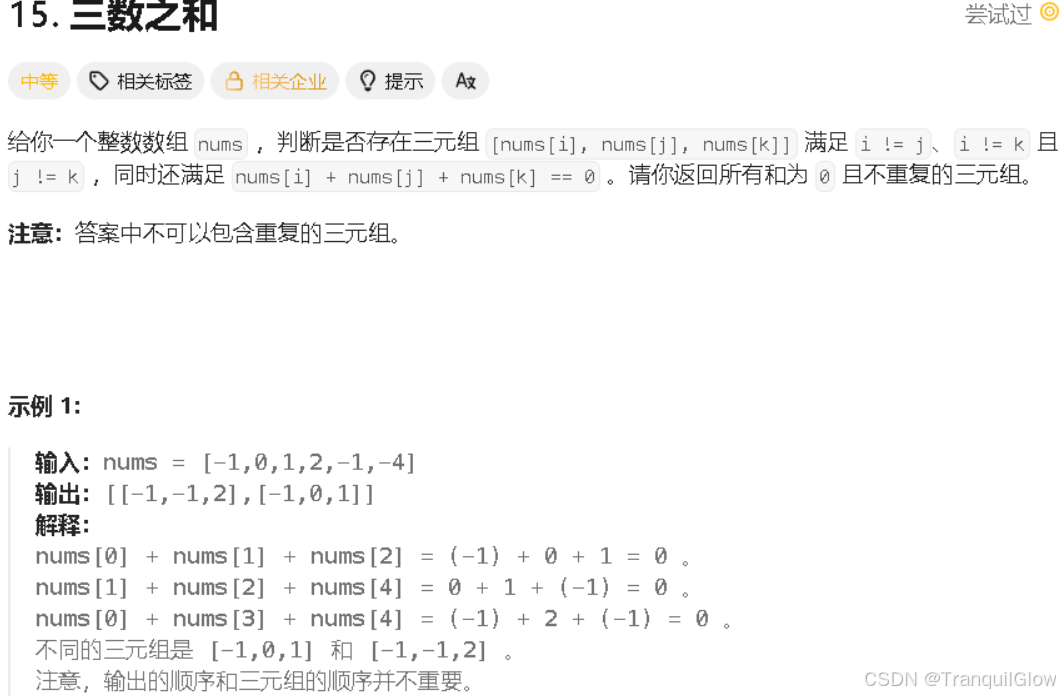
我的解法(不是完全解309/314)
-
我的思路是定义一个left和一个right,然后在向集合里去查询,看看有没有除了nums[left],和nums[right]的第三个元素,把这个问题转换为一个遍历查找问题
- 利用List.contains()方法来查找剩余元素
- 利用List.remove和List.add(),来模拟派出了nums[left]和nums[right]的集合
-
但是这种思路有个问题,就是时间复杂度太高了,我只通过了309/314的示例。
- 其中这个
ArrayList.contains是 O(n),ArrayList.remove(Integer)也是 O(n),然后外层有一个从left-length,有一个从length-left,循环接近O(n3),时间复杂度太高了 -
int left = 0,right =0; ArrayList<Integer> list = new ArrayList<>(); for(int num:nums){list.add(num); } List<List<Integer>> result = new ArrayList<>(); for(;left<nums.length-2;left++){list.remove(Integer.valueOf(nums[left]));List<Integer> temp = new ArrayList<>();int a =0;for(right=nums.length-1;right>left;right--){list.remove(Integer.valueOf(nums[right]));a = 0-nums[left]-nums[right];if(list.contains(a)){Collections.addAll(temp,nums[left],nums[right],a);List<Integer> temp2 = new ArrayList<>(temp);Collections.sort(temp2);if(!result.contains(temp2)){result.add(temp2);}temp.clear();}list.add(nums[right]);} } return result;
- 其中这个
-
改进1:对于这个代码我们需要想办法减少它的时间复杂度,为了遍历出所有情况,内外两层循环遍历是不能够改变的。所以我们可以想办法去减少这个查找的时间复杂度,将这个集合转换为哈希集合,这样查询的时间复杂度就变成了O(1)了
- 但是很遗憾,这个时间复杂度还是高了,还需要继续降时间复杂度
-
List<List<Integer>> result = new ArrayList<>(); // 用 HashMap 统计每个数字的出现次数(替代 ArrayList) Map<Integer, Integer> count = new HashMap<>(); for (int num : nums) {count.put(num, count.getOrDefault(num, 0) + 1); } // 为了去重,排序后按顺序枚举 int n = nums.length; for (int i = 0; i < n - 2; i++) {int left = nums[i];count.put(left, count.get(left) - 1); // 用掉一个 leftfor (int j = n-1; j >i; j--) {int right = nums[j];count.put(right, count.get(right) - 1); // 用掉一个 rightint target = 0 - left - right;// 检查剩余集合中是否有 targetif (count.getOrDefault(target, 0) > 0) {List<Integer> list = Arrays.asList(left, right, target);Collections.sort(list); // 排序以确保结果的唯一性if (!result.contains(list)) {result.add(list);}}// 把 right 加回来,供下一轮使用count.put(right, count.get(right) + 1);} } return result;
灵神的思路
-
灵神在讲这个题的时候先参考了这个 📄((20250730131645-jdjxatg ‘0167 两数之和II-输入有序数组’)) 这个题
如果是两个数的话,我们就可以使用两个指针进行快速的寻找
所以我们想想办法,看怎么使这个三个数的和变成两个数 -
我们可以通过先对这个数组进行排序,这样就和0167题具有了相同的初始条件,即数组有序
之后我们对这个数组进行遍历,先确定一个数,之后再剩余的数组中,找到两个数的和为0-这个数,此时就和0167题相似了。 -
有一个点,不太容易理解,就是为什么left是从i+1开始,而不是从别的地方开始
是因为,每次遍历的时候,都会把这个位置的所有情况给考虑到,后续的其它集合就不会包含这个元素//讲数组进行排序 Arrays.sort(nums); int n = nums.length; List<List<Integer>> ans = new ArrayList<>(); for( int i= 0; i<n-2;i++){if(i>0&&nums[i]==nums[i-1]){continue;//代表这个重复了}int left = i+1;int right= n-1;int target = 0 - nums[i];while(left<right){if(nums[left]+nums[right]>target){right--;}else if(nums[left]+nums[right]<target){left++;}else {ans.add(Arrays.asList(nums[i], nums[left], nums[right]));//之后的话进行下一轮,因为可能还有重复,我们将left和right修改//比如[-2,-2,-2,-2,4,4,4,4,4],这个地方就有可能重复left++;while(left<right&&nums[left]==nums[left-1]){left++;}right--;while(left<right&&nums[right]==nums[right+1]) {right--;}}} } return ans; -
如何剪枝
当我们确定了第一个数,发现它和这个排序后的数组中最大的两个数相加都小于0的话,那么这个都不用看了,不可能会有等于0的情况,我们此时切换到下一个数
当我们确定了第一个数,如果它和它紧挨着的两个数(靠近它最小的数)相加大于0,那么后续都会大于0,直接跳过 -
if(nums[i]+nums[i+1]+nums[i+2]>0){break; } if(nums[i]+nums[n-1]+nums[n-2]<0){continue; }
)


)

)




)








